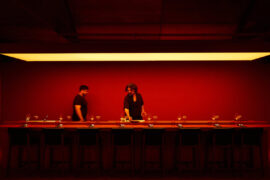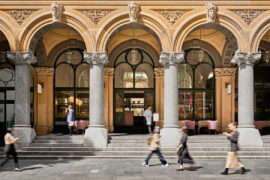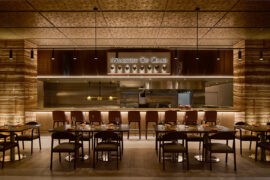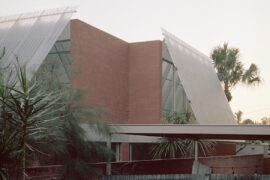Wild Back restaurant transports patrons to the wilderness despite its urban setting.

With a material palette limited to stone, exposed aggregate, recycled wood board, metal and paint there is a poetic simplicity to Pig Design’s realisation of Wild Back that ties it succinctly to nature: “The cafes in the city and the footprints left in the mountains and forests both represent the wonderful aspects of modern life. I often find myself lost in between these two worlds” say Li Wenqiang, project lead and founder of Pig Design.
Despite being housed on the street facing exterior of the Huanglong World Trade Centre, it is the serene nature of the adjacent West Lake that informs the casual grill café/restaurant’s mood. Here, the natural elements of stones, grassy slopes, and mountains come together to create a wilderness oasis, which is clearly referenced in both material palette and the architecturally sprawling design. Looking out to the untouched camping ground, as opposed to back to the city of Hangzhou, the design acts as a launching pad inviting guests to explore and enjoy nature.

Rather than rejecting the high polish of contemporary design, however, Pig Design has set out to create a space that says “yes, an unspoiled natural haven can exist within the urban landscape.” As such, Wild Back acts as a departure point for making the necessary adjustments to the overly refined and polished aspects of modern living: “The wilderness represents an unaltered state, showcasing the true essence of nature. It is a realm brimming with challenges and mysteries, offering profound significance to life’s journey,” says Wenqiang.
Continuing this metaphor, the charcoal grilling represents the original relationship between humans and fire, reinforcing the project’s aim of creating a narrative of dining in the wilderness, as Wenqiang explains: “The ‘outdoors’ has been regarded as an aesthetic proposition beyond its functions in this project. When dining in a restaurant surrounded by nature, one can truly feel a sense of symbiosis with the environment.”

Entering from the commercial tower, the experience of nature is slowly introduced through natural materials and increasingly open spaces. These in turn give way to the pavilion and corridor structures and public courtyards and finally the open vista. Conversely, when entering from the reserve, a low stone wall curving through gently landscaped lawn mounds dotted with large rocks, gently usher from outdoor nature to an interior space that remains connected.
Folding windows facilitate this seamless transition between indoors and out, while gently melding the indoor microclimate with the changing seasons. The large rocks, which began on the lawn continue across the threshold where they punctuate the interior space. As do tree branches, which jut from the side of the larger rocks deep within the café. Densely covered with foliage, the branches create shadow play across; both the minimal slightly camp-side furniture (all bespoke and designed by Pig Design), the stone floors, moss banks and the large natural rocks.
For the wine cellar, Pig Design has taken a cabin in the woods approach with Wenqiang hand placing each of the recycled pieces of timber. Looking to resemble a cabin rather than a modern build, the timber selected was the most weathered and aged to better create a contrasting rustic element.










INDESIGN is on instagram
Follow @indesignlive
A searchable and comprehensive guide for specifying leading products and their suppliers
Keep up to date with the latest and greatest from our industry BFF's!

For those who appreciate form as much as function, Gaggenau’s latest induction innovation delivers sculpted precision and effortless flexibility, disappearing seamlessly into the surface when not in use.

For a closer look behind the creative process, watch this video interview with Sebastian Nash, where he explores the making of King Living’s textile range – from fibre choices to design intent.

At the Munarra Centre for Regional Excellence on Yorta Yorta Country in Victoria, ARM Architecture and Milliken use PrintWorks™ technology to translate First Nations narratives into a layered, community-led floorscape.

In an industry where design intent is often diluted by value management and procurement pressures, Klaro Industrial Design positions manufacturing as a creative ally – allowing commercial interior designers to deliver unique pieces aligned to the project’s original vision.

Located in the former Madam Brussels rooftop, Disuko reimagines 1980s Tokyo nightlife through layered interiors, bespoke detailing and a flexible dining and bar experience designed by MAMAS Dining Group.

Luchetti Krelle’s timeless design at Epula marries heritage grandeur with classic sophistication, celebrating the spirit of a European piazza whilst remaining unmistakably of its place.
The internet never sleeps! Here's the stuff you might have missed

After more than two decades at Architects EAT, Eid Goh launches AIR, a new Melbourne-based studio focused on adaptive reuse, hospitality and human-centred design across commercial and civic projects.

With 26 shortlisted homes, a 13-member jury and four standout winners, the 2025 Habitus House of the Year program wrapped up last night in Sydney with Winnings.

At the Munarra Centre for Regional Excellence on Yorta Yorta Country in Victoria, ARM Architecture and Milliken use PrintWorks™ technology to translate First Nations narratives into a layered, community-led floorscape.